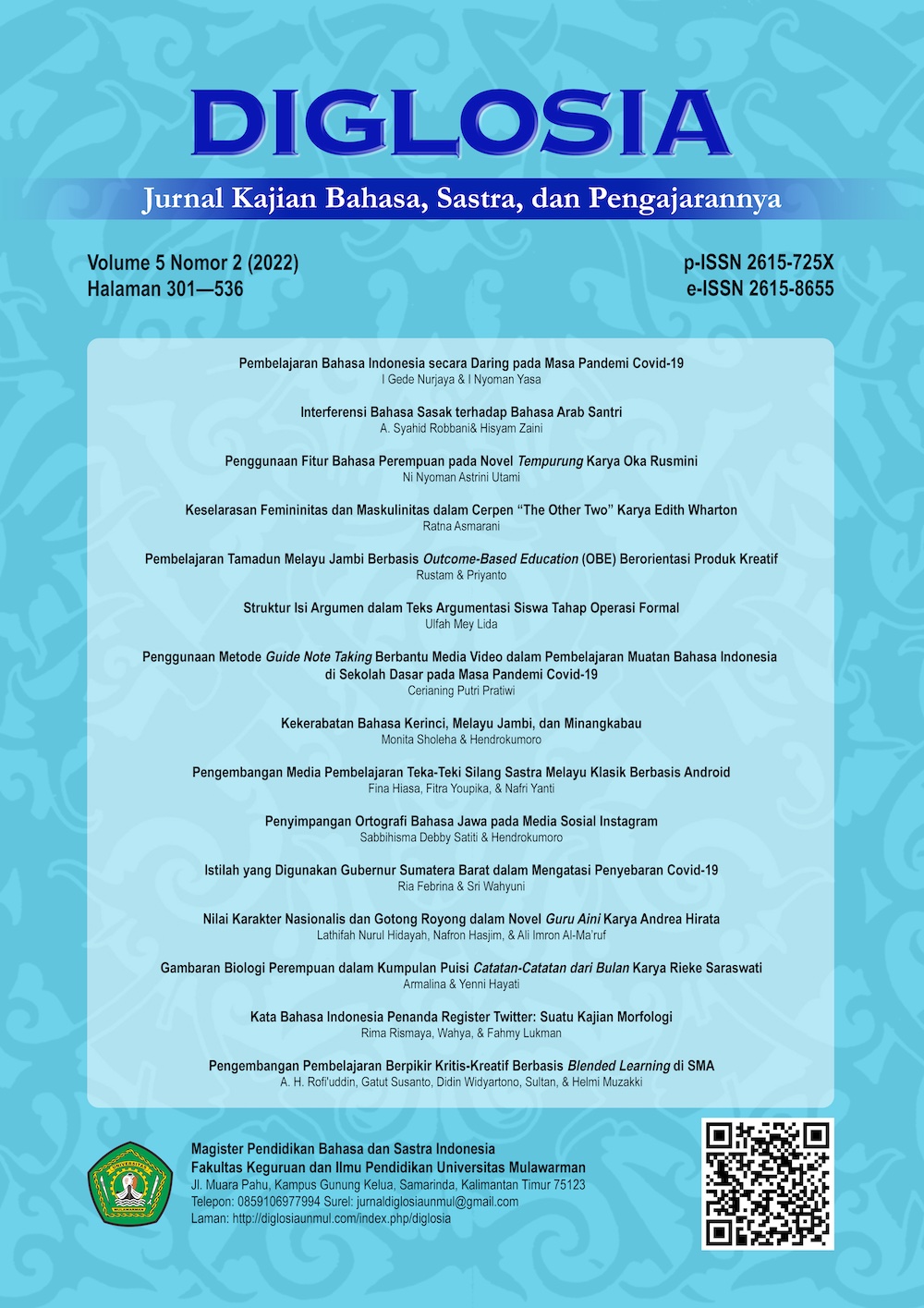Gambaran Biologi Perempuan dalam Kumpulan Puisi Catatan-Catatan dari Bulan Karya Rieke Saraswati Biological Description of Women in Rieke Saraswati’s Poetry Collection “Catatan-Catatan dari Bulan”: Gynocritic Studies
Main Article Content
Abstract
This study aims to describe the biological aspects of women contained in the poetry collection of "Catatan-Catatan dari Bulan" by Rieke Saraswati. This study uses a qualitative approach with a gynocritic approach that produces descriptive data in the form of written words. The author uses this biological aspect in his poetry to convey the mindset of resistance, dissatisfaction, and suppression experienced by women in society regardless of age. Based on the data analysis, 34 data about the biological aspects of women were found in the poetry collection of "Catatan-Catatan dari Bulan" by Rieke Saraswati. The biological aspects found in Rieke Saraswati's poetry collection of "Catatan-Catatan dari Bulan" using a gynocritic approach include four aspects, namely (1) female self-identity, which includes puberty, menstruation, pregnancy, childbirth, and breastfeeding; (2) women's sexual expression, in this aspect the author breaks the tradition in Indonesia which considers women's sexuality to be something that must be strictly controlled; (3) resistance to patriarchy, the author voices protest and opposition in response to things that befell women; and (4) the issue of gender inequality, this aspect is found chiefly in the poetry collection of "Catatan-Catatan dari Bulan", the author voices the injustices that women often experience. The aspect of celebrating women's biology is not found in Rieke Saraswati's poetry collection of "Catatan-Catatan dari Bulan". In this collection of poems, the author reveals the deprivation of women's rights in society.
Downloads
Article Details
![]()
Every work in Diglosia: Jurnal Kajian Bahasa, Sastra, dan Pengajarannya is licensed under a Creative Commons Attribution-ShareAlike 4.0 International License.
Under the following terms:
- Attribution — You must give appropriate credit , provide a link to the license, and indicate if changes were made . You may do so in any reasonable manner, but not in any way that suggests the licensor endorses you or your use.
- ShareAlike — If you remix, transform, or build upon the material, you must distribute your contributions under the same license as the original.
- No additional restrictions — You may not apply legal terms or technological measures that legally restrict others from doing anything the license permits.
Authors who publish with this journal agree to the following terms:
- Authors retain copyright and grant the journal right of first publication with the work simultaneously licensed under a CC BY-SA 4.0 DEED Attribution-ShareAlike 4.0 Internationalthat allows others to share the work with an acknowledgment of the work's authorship and initial publication in this journal.
- Authors are able to enter into separate, additional contractual arrangements for the non-exclusive distribution of the journal's published version of the work (e.g., post it to an institutional repository or publish it in a book), with an acknowledgment of its initial publication in this journal.
- Authors are permitted and encouraged to post their work online (e.g., in institutional repositories or on their website) prior to and during the submission process, as it can lead to productive exchanges, as well as earlier and greater citation of published work.
References
Asri, Y., & Hayati, Y. (2019). Construction of Women’s Roles in Patriarchal Culture (Feminist Study towards Modern Indonesian Novels). Proceedings of the Second Conference on Language, Literature, Education, and Culture (ICOLLITE 2018), 257, 43–47. https://doi.org/10.2991/icollite-18.2019.8
Auziņa, A. (2015). Female Experience and Language in Monta Kroma’s Poetry. Interlitteraria, 20(1), 204–214. https://doi.org/10.12697/IL.2015.20.1.15
Dilah, G., & Zahro’, A. (2021). Kecerdasan Emosional Tokoh Perempuan Muslimah dalam Novel Assalamualaikum Beijing Karya Asma Nadia. Diglosia: Jurnal Kajian Bahasa, Sastra, dan Pengajarannya, 4(1), 37–48. https://doi.org/10.30872/diglosia.v4i1.89
Djajanegara, S. (2003). Kritik Sastra Feminis: Sebuah Pengantar. Gramedia Pustaka Utama.
Haryanti, P., Sulistyorini, T. B., Kusmanto, H., & Rahmawati, L. E. (2019). Citra Perempuan dalam Lirik Lagu Bojo Galak Karya Pendhoza. Bahastra, 38(2), 113–121. https://doi.org/10.26555/bahastra.v38i2.11441
Ledger, S. (1993). Feminist Criticism in the Nineties. Literature & History, 2(2), 76–82. https://doi.org/10.1177/030619739300200207
Nordin, N. S. A., & Ya, C. A. C. (2018). Watak Wanita dalam Bidadari dari Perspektif Ginokritik: Penelitian Psikologi dan Budaya. Jurnal Wacana Sarjana, 2(4), 1–10. https://spaj.ukm.my/jws/index.php/jws/article/view/187
Purnamasari, I., & Fitriani, Y. (2020). Kajian Ginokritik pada Novel Namaku Teweraut Karya Ani Sekarningsih. Jurnal Pembahsi (Pembelajaran Bahasa dan Sastra Indonesia), 10(1), 1–15. https://doi.org/10.31851/pembahsi.v10i1.4421
Rahman, N. A. (2014). Puitika Sastera Wanita Indonesia dan Malaysia: Satu Bacaan Ginokritik. Penerbit Universiti Sains Malaysia.
Rahman, N. A., & Hearty, F. (2016). Kajian Perempuan Malaysia-Indonesia dalam Sastra (1st ed.). Yayasan Pustaka Obor Indonesia.
Saraswati, R. (2019). Catatan-Catatan dari Bulan. PT Gramedia Pustaka Utama.
Showalter, E. (1985). The New Feminist Criticism. Pantheon Books.
Tarigan, H. G. (2017). Prinsip-Prinsip Dasar Sastra. Angkasa.
Utomo, K. P. (2018). Pendhoza, Mantan Kuli Bangunan Jadi Jutawan Gara-Gara Bojo Galak. Brilio.net. https://www.brilio.net/video/selebritis/pendhoza-mantan-kuli-bangunan-jadi-jutawan-gara-gara-bojo-galak-180131o.html
Wiharja, I. A., & Fahmi, R. (2021). Gaya Bahasa dalam Antologi Puisi “Catatan-Catatan dari Bulan” Karya Rieke Saraswati. Lingua Rima: Jurnal Pendidikan Bahasa dan Sastra Indonesia, 10(1), 49–54. http://jurnal.umt.ac.id/index.php/lgrm/article/download/4088/2305
Yuswianti, Y., Syam, C., & Wartiningningsih, A. (2016). Analisis Ginokritik Novel Partikel Karya Dewi ‘Dee’ Lestari. Jurnal Pendidikan dan Pembelajaran, 5(8), 1–13. https://doi.org/10.26418/jppk.v5i8.16255

